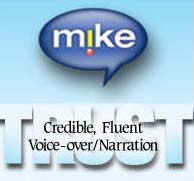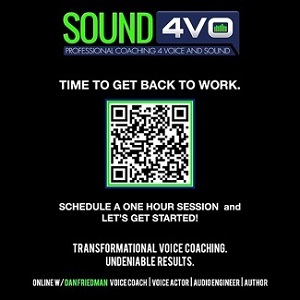|
HOME STUDIO STEREO or MONO: Which Setting Should You Choose To Record Your Voice Overs? October 8, 2015  By Mike Harrison By Mike HarrisonVoice Actor The most often-asked question regarding voice over is "How do I break into it?" Running a close second is: "Do I record my voice overs in stereo or mono?" What follows will explain all you need to know on the topic. First, the basics. What stereo is not: Stereo is not simply the use of two speakers or the use of what is called a stereo audio file. What stereo is: Stereo is a term given to sound recordings that feature different yet, most often, similar audio on the left and right channels. We hear "in stereo" (actually "surround," but that's an entirely different discussion) because each ear picks up different sounds from different directions. And it's because of our ability to hear this way that the concept of stereo in sound recordings (aka stereophonic sound) even exists. Again, just because we hear sound coming from two speakers does not make what we're hearing stereo. DIFFERENT SOUNDS FROM STEREO Stereo sound is made up of different, yet usually similar sound, designed to entertain our ability to hear different things from each ear. (Films produced in 3-D are an attempt to simulate the depth perception provided by our two eyes, each which see the same scene yet from a slightly different perspective.) BUT... simply because we might record our voice on two audio channels (sometimes called tracks), and while audio software may call it a stereo file, it is NOT a stereo recording. The recording simply uses two channels to record exactly the same audio, and that's why using a stereo file to record a single voice is unnecessary. FOR INSTANCE ... If we were to make a recording using two people conversing, each using their own microphone, routing one person's microphone to the left channel and the other person's microphone the right channel, that would be a stereo recording. If playback facilities were set up properly, we'd hear the person on the left channel coming from the left speaker, and the person on the right channel coming from the right speaker. LISTEN TO THIS ... Ready for an aural treat? Here's an excellent example of stereophonic sound, recorded many years ago, when the technology was still fairly new and being showcased. Make sure your sound system is in stereo mode and click here to listen. As a comparison, click here for the same recording in mono. The bottom line: For recording a single voice, it is pointless to record using two channels (a "stereo" file), because each channel will have exactly the same content, thus resulting in a file twice the size as a mono file, unnecessarily. And: What to do if your audio software defaults to creating a stereo file? No sweat. Record in the stereo file, but then convert it to mono before delivering to the client. *(Aristides) Zaccarias and his Orchestra, from the Living Stereo album "Dance The Bossa Nova," ©1962 RCA Records --------------------- ABOUT MIKE Since 1973, Mike Harrison has been engaged professionally in several fields (radio, corporate communications multimedia production, advertising) where work was performed in either acoustically-treated rooms with microphones and/or semi-darkened rooms filled with expensive equipment featuring pretty, often-blinking multi-colored lights and various knobs, switches and buttons, and whose innate skill with said equipment, particularly the fluency and speed with which he operates it, has been aptly described by the words, "wip, bom, bip, bom, boop." He also writes pretty darned good copy. |
|
|
Inspiring interviews help your VO career
Email alerts to new VoiceOverXtra articles
On Michael Langsner's Voice-Over Roadmap Podcast
With Sean Daeley and Paul Stefano - check it out!
As of the NEW website launch, 03/22/2012





.png)




And, thank you, Howard. I wanted a very obvious example of stereo, and Zaccarias fit the bill perfectly.
Also, I'm sure some clients might request a stereo file, but I tend to think that would be due to either their not realizing a mono source can be assigned to both left and right channels, or perhaps there's some other limitation. Of course, if a client specifically requests a stereo file, then that's what they should receive.
As for delivering files at 24 bit/48kHz, 48kHz is good, especially for video (but if the end product is audio-only, 44.1kHz is perfectly fine). However, while recording and adding any processing in 24 bit is good, to the average person's ear, there is no difference in quality between 24 and 16... and a 24 bit file is going to be larger. A one-minute 16 bit/44.1kHz mono file will be 5.292 MB, whereas the same length audio in 24 bit/48kHz will be 8.640 MB. Those values would be doubled for a stereo file. File size should be considered when delivering audio because a smaller file size for the end product is usually preferred.
Finally, yes; I've heard too many examples where, as you stated, the voice-over is drowned out by other elements. That is simply an example of bad mixing. Unless voice talents ask each client each time whether they'd prefer dynamic compression (which many won't understand), we cannot know or assume. The subject of mixing is one that needs to be addressed, too, but that'll be another discussion.
Providing a stereo file with one channel raw and the other processed (which may be tedious to accomplish and perhaps even impossible with some software) might be acceptable, but I'd check with the client first to ensure they can properly deal with that. Unless I'm delivering audio to a studio, most of my clients don't know very much about this stuff at all. If I wanted to be safe in a case like this, I'd send two separate mono files along with an explanation.
The use (or overuse) of compression is also another topic for discussion, but I'll quickly say when the voice-over will not be mixed with music or other elements, compression really isn't necessary unless the audio level is inconsistent (extremely quiet passages punctuated by very loud passages). The "fat," always-loud sound heard on radio stations is not good for applications such as eLearning, for example, where a person listens for extended periods of time, because it becomes tiring to listen to after only a short time.
In the same vein, front office clients tend to request mp3 - synonymous in their mind with audio in general - when their engineer would much prefer an uncompressed wav or aiff. When there's no time to enquire, I default to 24/48 mono.
So, while you are discussing channels, I have a query! A guessing game in remote working is dynamic processing: clients with the blessing of a real engineer want a raw file, while others just drop what they get into their film - in which case it will be drowned by music and FX unless pre-treated. I'm not the first to wonder about supplying raw on one channel and processed on the other, so client/engineer can choose. Does anyone do that? Would it be awkward in studio?